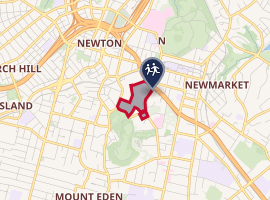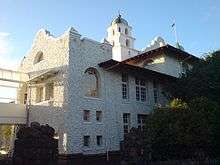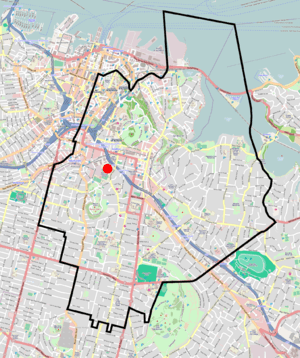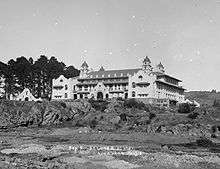Auckland Grammar School
Auckland Grammar School (simply referred to as AGS or Grammar) is a state, day and boarding secondary school for boys in Epsom, Auckland, New Zealand. It was established in 1868.
| Auckland Grammar School | |
|---|---|
 The school is built in Spanish Mission style architecture. | |
| Address | |
Mountain Road, Epsom , 1023 New Zealand | |
| Coordinates | 36°52′9″S 174°46′10″E |
| Information | |
| Other names |
|
| Type | State, day and boarding secondary school |
| Motto | Latin: Per Angusta ad Augusta (Through difficulties to greatness) |
| Established | 1869 |
| Sister school | Epsom Girls' Grammar School |
| Ministry of Education Institution no. | 54 |
| Headmaster | Tim O'Connor |
| Years offered | 9–13 |
| Gender | Boys |
| Colour(s) | Navy blue and gold |
| School roll | 2622 (March 2020)[1] |
| Socio-economic decile | 9[2] |
| Website | www |

| |
The local publication Metro claimed that "Grammar's results in the Cambridge system are comparable with most private schools, and it scores extremely well in Scholarship too".[3] It was ranked seventh in the Crimson-QS Best New Zealand schools in 2019 for getting into top-ranked universities.[4]
History
The school was endowed in 1850 by the then Governor-in-Chief, Sir George Grey,[5] and was recognised as an educational establishment in 1868 through the Grammar School Appropriation Act.[6][7] It officially opened in 1869.[5] The school was initially privately funded, as New Zealand did not have a state education system until 1877.
Auckland Grammar School buildings contain two Category I historic places, the school's main block and a war memorial.[8][9][10] An obelisk located in front of the school commemorates former students who fought in various wars. The school's main block, built in 1916 in the Spanish Mission style, is used for daily assemblies, exhibitions, and contains various classrooms. Surrounding the main hall in which the daily assembly is held are the school honours boards listing the names of the school's top scholars including Rhodes Scholars and Girdlers Scholars.
The school owns a facility called the VentureLodge located in the township of Ohakune, in the central North Island, which is used by students for camps.[11]
The school's motto is Latin: Per Angusta ad Augusta which translates to "Through difficulties to greatness." The school has also translated the motto as "Through rough ravines to hallowed heights."[12] The origin of the motto is uncertain, but it was a common maxim at the time of the school's founding.[13]
A documentary on the school titled Grammar Boys was aired in July 2005 on TV3.[14]
Architecture

The main building was constructed in 1916, designed by the architectural firm of Arnold & Abbot. It, and the adjacent caretakers residence are in the Spanish Mission style and probably the earliest example of that style in the country. Following the completion of the main building, three smaller buildings were constructed in the same style; The Library block to the north, the Gymnasium to the south and a toilet block adjoining the main building. In the 1950s, a large Science block was constructed to the south of the main block in a modern style with metal windows. Further to the South again is a concrete Block from the early 1970s raised on Pilotis to give access to the upper playing fields. Between it and the 1920 Gymnasium is a large Gymnasium which was constructed in the mid 1970s and opened by the Prime Minister Robert Muldoon.
Adjacent to the Spanish Mission Style Library from the 1920s is the Centennial Theatre (opened 1969) and the Swimming Pool. This abuts the Motorway, the construction of which in the 1960s removed some of the School's land to the north. Between the 1970s and 2014-2015 a complex of 'prefabs' adjacent to the Mountain Road boundary evolved, built to house the increasing roll, but following the development of a new classroom block in 2015 (see below), these have now been almost entirely removed. The loss of playing space on the upper part of the school property meant new Sports Fields need to be created in two former quarries at a lower level than the original school. Each has a sports Pavilion. Recently the pavilion on the upper field was rebuilt.[15]
Between 2014 and 2015, the toilet block adjoining the main building (affectionately know to generations of pupils as the 'Taj', due to its Spanish Mission-style dome) was demolished and a new building constructed in its place for classroom use.[16]
Enrolment

Historically, because of its reputation, the demand for places in the school has outstripped capacity, and entry was selective. The school was zoned at least since the 1960s. Since 2000, school zoning is determined by a state school enrolment scheme, which gives first preference to students living in a designated home zone, and then to brothers of current students who live outside the zone. The school argues that zoning increases house prices in the zone, reducing access to the school for students from lower socio-economic groups.[17] Research by the Real Estate Institute of New Zealand shows there is a 30 percent premium ($257,000) on houses in-zone compared to those out of zone.[18] In 2014, nearby One Tree Hill College and Selwyn College introduced enrolment schemes which initially planned to overlap parts of the Auckland Grammar zone. Both were forced to backtrack after opposition from parents in the overlapping areas, who feared it could ultimately lead to Auckland Grammar shrinking its zone and affecting the resale value of their homes.[19]
Auckland Grammar's requested voluntary donation is the highest for a non-integrated state school in New Zealand. In 2014, the requested donation reached $1,050 per student per year. The school claimed the donation is high to cover the gap in government funding between it, a decile 9Q school, and the lowest decile schools (i.e. decile 1A).[20] As a comparison, Auckland Grammar's female counterpart, Epsom Girls' Grammar School, asks for a donation of $665,[21] despite also being decile 9Q.
International students are tested for English language proficiency and some students may be required to complete an intensive course of English language before starting at Auckland Grammar School. The international students at Auckland Grammar School paid the highest tuition fees in New Zealand state schools at more than $20,000 each year.[22][23]
Academics
As a state school, Auckland Grammar School is required to follow the New Zealand Curriculum (NZC).
Results
In 2015, 95.1 percent of students leaving Auckland Grammar held at least NCEA Level 1 or IGCSE, 91.6 percent held at least NCEA Level 2 or AS level, and 81.5 percent held at least NCEA Level 3 or A level. This is compared to 87.1%, 76.3%, and 45.8% respectively for boys nationally.[24]
NCEA
The last headmaster, John Morris, is a vocal critic of NCEA. In response to what is perceived by the school to be a poorly designed system being forced on them, the school introduced Cambridge International Examinations in 2002, offering the IGCSE, AS Level and A2 examinations to its more talented students. Other students sit NCEA exams. Students placed in an IGCSE/AS/A2 class are allowed to switch to NCEA, but this is usually discouraged by the school. However, in the ensuing years the majority of students were encouraged to take part in CIE qualifications. The introduction of New Zealand Scholarship has been viewed sceptically by the school, and it encourages only the top students to attempt it. Despite this, the school had the highest number of scholarships of any school in New Zealand in 2006.[25] The 2008 Education Review Office (ERO) report commented the School ranks among the highest performing schools in New Zealand from the results in national and international examinations.[26] From 2011, the school offered the CIE Form 5 programme to all students in Form 5.[27] From 2019, the School will replace all external examinations (both Cambridge IGCSE and NCEA Level 1) for Fifth Formers with an in-house preparatory qualification, Pre-Q, set to be "more rigorous than IGCSE", in response to planned reforms to NCEA, abolishing external examinations at Level 1.[28]
School song
The school song was introduced in March 1955. The words were composed in 1954 by L. W. A. Crawley, senior Classics lecturer at Auckland University College (now the University of Auckland). The song consists of two verses in Latin and includes the school motto as a refrain. It is sung to the melody of the German hymn "Ein feste Burg ist unser Gott" ("A Mighty Fortress Is Our God").[29]
Headmasters
The following individuals have served as headmaster of Auckland Grammar School:
- Dr Robert Boyd Kidd: 1869–1870
- Farquhar Macrae: 1871–1882
- Charles Frederick Bourne: 1882–1892
- James William Tibbs: 1893–1922
- James Drummond: 1922–1928
- Harold James Del Monte Mahon: 1928–1935
- Colin McGregor Littlejohn: 1935–1954
- Sir Henry Cooper: 1954–1972
- Sir John Graham: 1973–1993
- John Morris: 1994–2012
- Tim O'Connor: 2012–present
Notable alumni

Academia
- Norman Lowther Edson, professor
- Denis Feeney, professor[30]
- Raymond Firth, ethnologist
- Dave Gerrard, sports administrator, sports medicine specialist, and former Olympic Games swimming representative
- Keith Hunter, ocean chemist
- Vaughan Jones, mathematician
- Hugh Kāwharu, Māori scholar[31]
- Colin Maiden, mechanical engineer, university administrator and company director[32]
- Joseph Peart, army officer and fourth Headmaster of King's College, Auckland
- John Reid, professor
The arts
- Russell Crowe, actor, film producer and musician
- Gerald Garrick Cunningham, author, photographer, historian and businessman
- Les Gibbard, political cartoonist, journalist, illustrator and animator[33]
- Max Gimblett, artist[34]
- Charles Frederick Goldie, artist[35]
- Zane Lowe, DJ, record producer, and television presenter
- James McNeish, novelist, playwright and biographer[36]
- Andrew Niccol, screenwriter, producer, and director[37]
- Graeme Revell, musician and composer
Broadcasting
- John Hawkesby, news presenter
Business
- John Buchanan, scientist and director
- Richard Chandler, billionaire investor
- Ernest Davis, businessman
- James Fletcher Jnr, industrialist[38]
- Terry Jarvis, cricket player and sales representative
- Ian Narev, former managing director and chief executive officer of the Commonwealth Bank
Literature
- A. R. D. Fairburn, poet
- R. A. K. Mason, poet
- John Mulgan, writer, journalist and editor
Military
- Cyril Bassett, Victoria Cross Recipient
- Ray Hanna, fighter pilot
Public service
- Alfred E. Allen, politician[39]
- Avery Ng, Hong Kong politician and social activist
- David Baragwanath, lawyer and jurist[36]
- Thomas Bavin, 24th Premier of New South Wales[40]
- Francis Bell, lawyer and politician, 20th Prime Minister of New Zealand
- Edward Caradus, analytical chemist, educator and administrator
- Jonathan Coleman, politician
- Roger Douglas, politician and 35th Minister of Finance
- Israel Goldstine, politician, businessman, barrister and solicitor
- Doug Graham, politician[41]
- Eric Halstead, politician
- Kenneth Hayr, senior Royal Air Force commander
- Jonathan Hunt, politician
- Kenneth Keith, judge[42]
- George Laking, diplomat[43]
- Sam Lotu-Iiga, Member of Parliament
- David Seymour, Member of Parliament
- Douglas Maclean, farmer and Member of Parliament[44]
- Duncan McMullin, jurist
- Leslie Munro, lawyer, journalist, and politician[45]
- Lockwood Smith, politician and diplomat
- Graham Speight, High Court judge
Science
- Raoul Franklin, physicist
- Peter Gluckman, scientist
- Matthew Hunter, metallurgist and inventor of the Hunter process
- Graham Liggins, medical scientist[46]
Sport
As of 2015, Auckland Grammar has produced the most All Blacks out of any New Zealand school; it has a total of over 50 former All Blacks.[47][48]
- Ben Atiga, All Blacks player[49]
- Ces Badeley, All Blacks player
- Vic Badeley, All Blacks player
- Mark Burgess, cricketer
- Hamish Carter, triathlete[50]
- Jeff Crowe, cricketer[51]
- Martin Crowe, cricketer[51]
- John Drake, All Blacks player
- Grant Fox, All Blacks player[52]
- Aaron Gate, racing cyclist
- Edmund Hillary, mountaineer, explorer, and philanthropist[53]
- Doug Howlett, rugby union player
- Konrad Hurrell, rugby league player
- Akira Ioane, All Blacks player
- Rieko Ioane, All Blacks player
- James Neesham, cricketer
- Matthew Ridge, television presenter, and former rugby union and rugby league player
- Tom Schnackenberg, sailor and yacht designer
- Benson Stanley, All Blacks player
- Jeremy Stanley, All Blacks player
- Kel Tremain, All Blacks player
- Sam Webster, track cyclist
- Wilson Whineray, All Blacks player[54]
Notable staff
- Graham Henry, former teacher[55]
See also
References
- "New Zealand Schools Directory". New Zealand Ministry of Education. Retrieved 26 April 2020.
- "Decile Change 2014 to 2015 for State & State Integrated Schools". Ministry of Education. Retrieved 12 February 2015.
- "Auckland Grammar School". Metro Magazine. July–August 2011.
- "Crimson-QS Best NZ Schools 2019". Crimson Education. Retrieved 30 September 2019.
- "Our History". Auckland Grammar School. Retrieved 26 November 2019.
- "Enrolment". Auckland Grammar School. Archived from the original on 21 June 2006. Retrieved 2 July 2006.
- "Grammar School Appropriation Act" (PDF). 1868.
- "Auckland Grammar School (Main Block)". Register of Historic Places. Heritage New Zealand. Retrieved 2 July 2006.
- "War Memorial, Auckland Grammar School". Register of Historic Places. Heritage New Zealand. Retrieved 2 July 2006.
- "School Campus". Auckland Grammar School. Archived from the original on 5 May 2006. Retrieved 2 July 2006.
- Venture Lodge | Auckland Grammar School. Ags.school.nz. Retrieved 10 August 2011.
- Trembath, 358.
- Trembath, 55.
- "Programme Catalogue". New Zealand On Air. Archived from the original on 27 September 2007. Retrieved 2 July 2006.
- About Grammar | Auckland Grammar School. Ags.school.nz. Retrieved 10 August 2011.
- https://www.ags.school.nz/our-community/news-and-messages/show/3290
- Enrolment | Auckland Grammar School. Ags.school.nz (6 September 2010). Retrieved 10 August 2011.
- Nichols, Lane (27 January 2015). "Revealed: Cost of buying in Auckland's top school zones". The New Zealand Herald. Retrieved 24 February 2015.
- Jones, Nicholas (23 July 2014). "College backs down on zoning plan after hostile feedback". The New Zealand Herald. Retrieved 4 November 2014.
- Wynn, Kirsty (26 January 2014). "Auckland school donation exceeds $1k". The New Zealand Herald. Retrieved 17 February 2015.
- "Financial Support". Epsom Girls' Grammar School. Archived from the original on 17 February 2015. Retrieved 17 February 2015.
- "Archived copy". Archived from the original on 2 May 2014. Retrieved 27 April 2012.CS1 maint: archived copy as title (link)
- Application Process for International Students | Auckland Grammar School. Ags.school.nz. Retrieved 10 August 2011.
- "School Qualifications -- Auckland Grammar School". Ministry of Education. Retrieved 28 January 2017.
- "NCEA Scholarship Results 2006". Auckland Grammar School. 7 May 2006. Archived from the original on 30 June 2007. Retrieved 5 July 2007.
- Review Report, Education (7 October 2008). "Education REVIEW REPORT:AUCKLAND GRAMMAR SCHOOL, OCTOBER 2008". Education Review Office. Retrieved 7 June 2010.
- "Extension of IGCSE to Form 5 in 2011". Auckland Grammar School. 26 June 2010. Retrieved 7 June 2010.
- "Auckland Grammar revolts against planned NCEA changes". Radio New Zealand. 30 May 2018. Retrieved 13 November 2018.
- Trembath, 313.
- "Denis Feeney '68" (PDF). Auckland Grammar School. Retrieved 10 August 2011.
- "Sir Hugh Kawharu". Auckland Grammar School. Retrieved 10 August 2011.
- Parker, Tamsyn (1 August 2008). "A serial director who has seen it all". NZ Herald. Retrieved 1 October 2019.
- Bryant, Mark (22 October 2010). "Les Gibbard: Artist held to be one of the finest political cartoonists of his generation". The Independent.
- "Max Gimblett '50" (PDF). Auckland Grammar School. Retrieved 10 August 2011.
- Blackley, Roger (1996). "Goldie, Charles Frederick". Te Ara - the Encyclopedia of New Zealand. Dictionary of New Zealand Biography. Retrieved 1 October 2019.
- "Augusta Awards" (PDF). Auckland Grammar School. p. 22.
- "Media / NEWZEDGE : Arts: Russell Crowe". The New Zealand Edge.
- "BIOGRAPHY - Sir James Fletcher". The Fletcher Trust. Retrieved 10 August 2011.
- Gustafson, Barry (1986). The First 50 Years : A History of the New Zealand National Party. Auckland: Reed Methuen. pp. 296–297. ISBN 0-474-00177-6.
- "Sir Thomas Rainsford Bavin". Former Members of the Parliament of New South Wales. Retrieved 12 May 2019.
- "Hon Douglas Graham". New Zealand Executive Government. Archived from the original on 2 June 2008. Retrieved 10 August 2011.
- "Sir Kenneth Keith". Auckland Grammar School. Retrieved 10 August 2011.
- "Sir George Laking dies, ending a life of public service". Stuff. 18 February 2009. Retrieved 1 October 2019.
- "Obituary". Auckland Star. LX (33). 8 February 1929. p. 9. Retrieved 18 May 2013.
- "Sir Leslie Munro (New Zealand) Elected President of the Twelfth Session of the General Assembly". United Nations. Archived from the original on 2 May 2011. Retrieved 10 August 2011.
- "Sir Graham Liggins". Auckland Grammar School. Retrieved 10 August 2011.
- "All Sports". Auckland Grammar School. Retrieved 18 April 2015.
- Browning, Jennifer (30 October 2015). "Rugby World Cup: All Blacks keep rolling off the Auckland Grammar production line". ABC News. Retrieved 1 October 2019.
- Knight, Lindsay. "Ben Atiga #1037". Stats. All Blacks. Retrieved 1 October 2019.
- "Hamish Carter". Auckland Grammar School. Retrieved 10 August 2011.
- "Russell Crowe". Media Man Australia. Retrieved 10 August 2011.
- Knight, Lindsay. "Grant Fox #857". Stats. All Blacks. Retrieved 1 October 2019.
- "Sir Edmund Hillary". Auckland Grammar School. Retrieved 10 August 2011.
- Knight, Lindsay. "Wilson Whineray #585". Stats. All Blacks. Retrieved 1 October 2019.
- "Wales Coach Archive: Graham Henry: 1998 – 2002". Welsh Rugby Union. Archived from the original on 14 August 2011. Retrieved 1 October 2019.
Bibliography
- Nicholls ("Streak"), C. N. (1987). Fifty Years at Grammar or Tales out of School. Auckland: ESA Books.
- Trembath, K. A. (1969). Ad Augusta. Auckland: The Auckland Grammar School Old Boys' Association. OCLC 447653.
External links
| Wikimedia Commons has media related to Auckland Grammar School. |